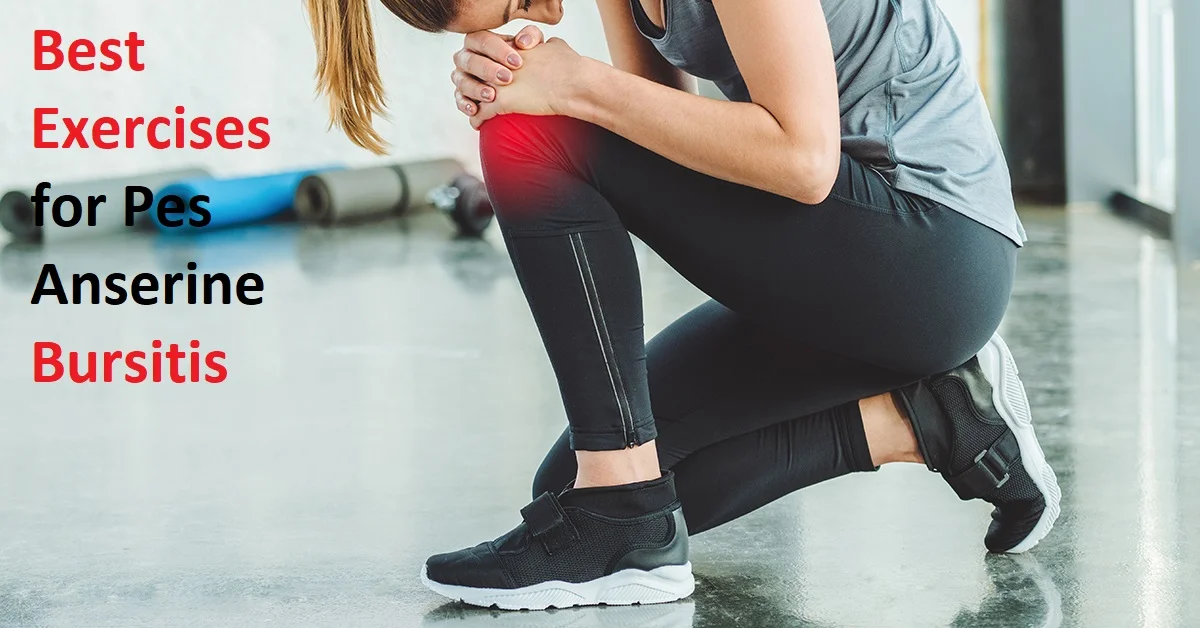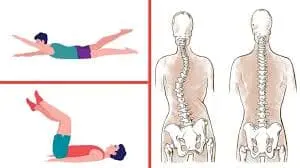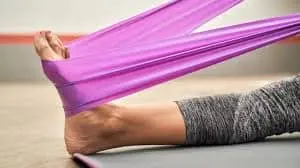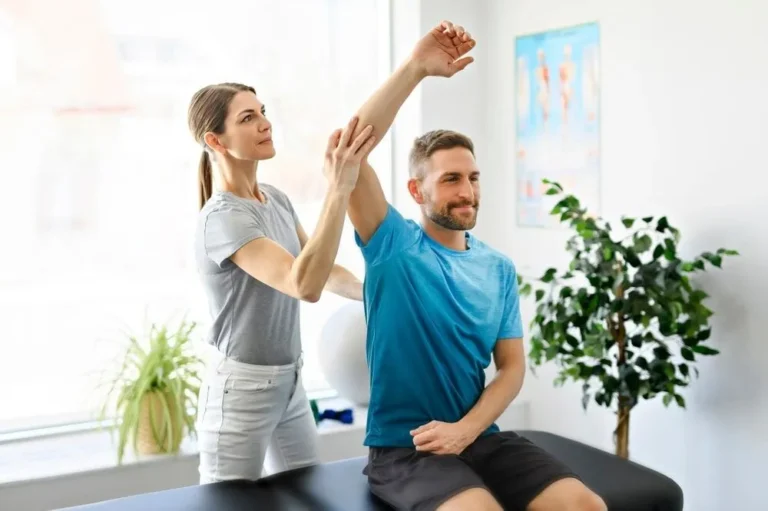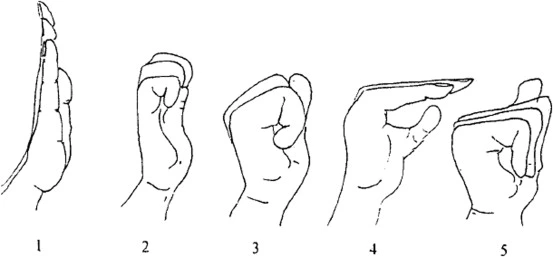16 Best Exercises for Pes Anserine Bursitis
Introduction:
Exercises for Pes Anserine Bursitis are an essential part of your overall treatment plan, along with medication and physical therapy.
One condition that might result from muscular instability around your knee joint is pes anserine bursitis. Most injuries require exercise to help them heal. Exercises that focus on your tendons and muscles can reduce your pain.
Exercise helps build stronger muscles. Exercise increases function and strength. Physical therapy and focused strengthening exercises can help you achieve better knee function with less pain. You can maintain proper posture by exercising. Stretching is a very useful and efficient treatment for pesanserine knee pain.
What is pes anserine bursitis?
The sartorius, gracilis, and semitendinosus tendons, three separate thigh muscles, come together to form the large tendon known as the pes anserine. The pes anserine protects against rotational stress and stabilizes the inside side of the knee in conjunction with these muscles.
This pes anserine bursa is located precisely on top of the anserine pes. In between tendons and bones, bursae are microscopic fluid-filled sacs that serve as cushions. They reduce friction by moving. As the pes anserine becomes inflamed, inflammation of the underlying bursa may lead to bursitis.
Pain, tenderness, and swelling are signs of pes anserine bursitis. Particularly, 4 to 5 centimeters below the knee, on the inner side of the shinbone, is where these symptoms are found. Repetitive knee bending, running, and stair climbing aggravate pes anserine bursitis.
Cause:
Pes anserine bursitis is a common condition in athletes, especially runners, and is also associated with osteoarthritis in the knee. Bursitis typically results from overuse or continuous friction and stress on the bursa.
Pes anserine bursitis can happen as a result of various factors, such as;
- Using improper training methods, such as skipping stretches, running too many hills, and making sudden mileage increases
- Tense hamstrings muscles
- Overweight
- Having knock-kneed knees or having duck feet
- Arthritis of the knee joint
Signs and symptoms:
Pain is a common symptom of pes anserine bursitis. After the joint has been in a fixed position for some time, the pain might be worse in the morning. The degree of pain you experience depends on the severity of your condition.
The following are typical signs of pes anserine bursitis;
- Pain on the inside of your knee or in the middle of your shinbone that gradually spreads to a location two to three inches below the knee joint
- Pain that could radiate down the lower leg and to the front of the knee
- Pain that gets worse when you exercise or go up and down stairs
- Pain that wakes you up when you’re sleeping on your side
- Pain that gets worse when one sits up from a chair or crosses one’s legs
- Localized swelling or tenderness to the touch in the affected area Knee
- Joint muscle weakness and reduced range of motion
Exercise’s advantages for pes anserine bursitis:
- Strengthen balance or posture
- Relaxing muscles
- lessen pain
- Improve movement
- Improved flexibility
- Increased level of physical fitness
- Improves performance in daily activities
- Improved Range of Motion
- Reduce inflammation
Before beginning a workout plan, take the following actions:
It’s important to go through a few safety precautions and maximize the advantages before starting any exercise program. To find out which exercises are best for your particular issue, speak with a doctor or physical therapist.
You must pay attention to your body and avoid pushing beyond difficulties. Although pain after exercise is common, chronic or intense pain could suggest that you’re pushing yourself too hard. Your best bet is low-impact exercises, which you should gradually transition to more difficult ones as soon as you are able.
Maintaining correct technique and posture is important to prevent additional injuries. See a physical therapist if you have any questions about how to successfully carry out your exercise routine correctly. Warm up your joints and muscles before beginning any activity to help them get ready for the workout.
Exercises for Pes Anserine Bursitis:
The management of pes anserine bursitis can benefit from exercise. Knee function can be improved and pain can be reduced with the use of physical therapy and targeted strengthening exercises. Additionally, stretching exercises can help you stay flexible and lower your chance of having attacks in the future.
To create a suitable exercise program, speak with a physician or physical therapist. If done incorrectly, some exercises can make symptoms worse.
Straight leg raise
- Comfortably in a supine position on the bed or floor to begin.
- Now flex just one knee.
- After that, carefully raise your whole leg off the table.
- Maintaining the straightness of your opposite knee.
- For a short while, hold it.
- Slowly bring your leg back down to the floor.
- Then return to your neutral position.
- Then relax.
- Repeat this exercise five to ten times.
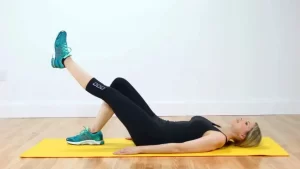
Calf stretch
- Place yourself on the ground and stand with your legs straight in front of you.
- Using both hands, loop the towel around the heel of your foot.
- Using the cloth, turn your foot back toward you.
- Hold this position for a few seconds.
- Maintain a straight knee.
- Then return to your neutral position.
- Then relax.
- Repeat this exercise five to ten times.
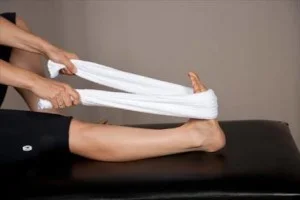
Heel slide
- To start, take a comfortable supine position on the bed or table.
- Next, extend the affected leg towards the buttocks while bending at the knees.
- Attempt to put your heels on the buttocks.
- Feel until you find a comfortable position.
- Hold this position for a few seconds.
- Straighten your leg now, carefully.
- Then return to your neutral position.
- Then relax.
- Repeat this exercise five to ten times.
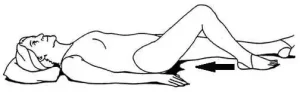
Static quadriceps exercises
- Laying or sitting on your back with support for your back, extend your legs straight in front of you.
- Place a tiny towel under your knee and roll it up.
- Pull the other foot toward you while moving the first one slightly to the side.
- As you firmly press your knee down, your thigh muscles will contract.
- Hold this position for a few seconds.
- Then return to your neutral position.
- Then relax.
- Repeat this exercise five to ten times.

Leg extensions
- Sit up straight in a long chair and place your leg on the floor or a plinth to start.
- Tighten your thigh muscles, face forward, and raise one leg as high as you can to build strength without getting off the chair.
- Hold this position for a few seconds.
- Then return to your neutral position.
- Then relax.
- Repeat this exercise five to ten times.
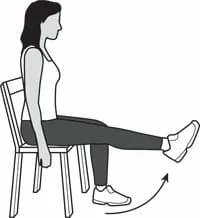
Lunges
- Start by placing your feet hip-width apart on the floor in a comfortable standing position.
- Now take a step forward that is longer than a walking stride, putting one leg in front of the other.
- When your foot touches the ground, it should land and stay level.
- Now lower yourself while bending your knees to around a 90-degree angle.
- Hold this position for a few seconds.
- Do not forget to maintain a straight core.
- After that, slowly raise your front leg and take a step back to your starting point.
- Then relax.
- Repeat this exercise five to ten times.
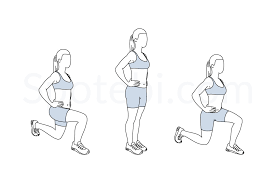
Hamstring curls
- Starting by taking a comfortable position on the ground.
- Place your hands on your waist or a chair to stay balance.
- Put your left leg behind your body.
- With your heel pointing toward your butt, slowly bend your right knee.
- Maintain a parallel thigh.
- Hold this position for a few seconds.
- Then return to your neutral position.
- Then relax.
- Repeat this exercise five to ten times.
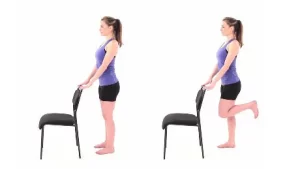
Clamshell
- You begin by lying on your side.
- Bend your elbow while lying on your left side.
- Next, raise the support to your head with your left hand.
- After placing your right foot and leg on top of your left, flex your knees to a 45-degree angle.
- For balance, place your right hand on your hip or lightly on the ground in front of you.
- Next, slowly lift your right knee toward the sky while keeping your feet close to your body.
- Keep your core tight as you raise your lower right leg back up to meet your left.
- Hold this position for a few seconds.
- Then return to your neutral position.
- Then relax.
- Repeat this exercise five to ten times.
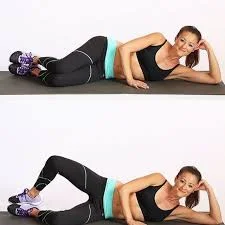
Standing quadriceps stretch
- Begin in a comfortable standing position.
- Use a chair or wall to support yourself.
- Maintaining your grip on your left ankle, bend to your left knee.
- Behind the body, move the left foot.
- With your hand on the ankle, attempt to pull the leg up and back.
- Hold this position for a few seconds.
- Remember to maintain a straight posture and parallel knees.
- Your knee side and thighs may feel stretched.
- Slowly move your leg back to your neutral position.
- Then relax.
- Repeat this exercise five to ten times.
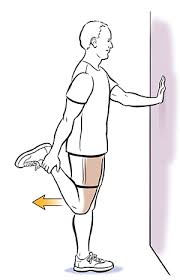
Hamstring stretch
- Put both of your knees on the floor, bent.
- Place your hands behind your leg and just behind your knee.
- Stretch your leg out straight and then slowly raise it to your head till it reaches your head.
- You can loop towels over your thigh if you have difficulty getting your hands behind your leg.
- Grasping it with your hand, move your leg closer to you.
- Hold this position for a few seconds.
- Let go after a short while.
- Then return to your neutral position.
- Then relax.
- Repeat this exercise five to ten times.
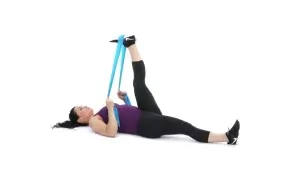
Prone knee bend
- On the bed or table, take a comfortable position while lying prone.
- At this point, gradually bend your knee to a tolerable position.
- Hold it for a short while.
- Next, progressively bring your leg back to its neutral posture.
- Then return to your neutral position.
- Then relax.
- Repeat this exercise five to ten times.
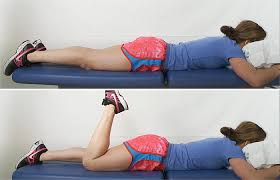
Prone leg raise
- Instead of a hard floor, you can use a mat or a plinth to give yourself some support during this exercise.
- Initially, you can extend your legs behind you while lying on your stomach.
- You can rest your head on your arms if that makes you uncomfortable.
- Stretch your left leg as far as you can without experiencing any pain by bending your gluteus and hamstring muscles.
- Before starting this exercise, make sure the physical therapist has stabilized your pelvic bones.
- Hold this position for a few seconds.
- Then return to your neutral position.
- Then relax.
- Repeat this exercise five to ten times.
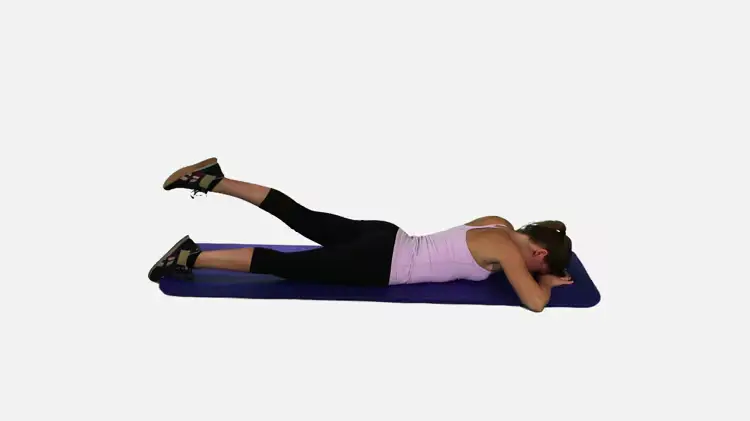
Wall Squats
- The starting point is to stand close to the wall.
- Keep your feet planted on the ground.
- If at all possible, back up against a wall.
- Ensure the distance between your feet is shoulder-width.
- While keeping your back and pelvis against the wall, progressively bend your knees.
- Don’t push yourself too hard.
- Hold this position for a few seconds.
- Then return to your neutral position.
- Then relax.
- Repeat this exercise five to ten times.
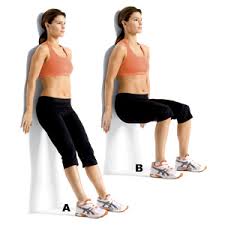
Hip adductor stretch
- Put your feet together in front of you while lying on the ground.
- Extend your knees to the sides.
- Putting your hands on your feet, pull your heels toward you.
- As you let your knees loosen and progressively approach the floor, maintain a straight back and a contracted abdominis.
- There will be a little pressure applied to your pelvic area.
- Inhale deeply, then hold this posture for a few seconds.
- Then return to your neutral position.
- Then relax.
- Repeat this exercise five to ten times.
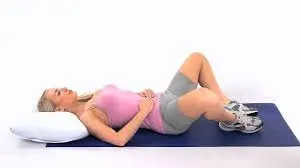
Sidelying Hip Adduction
- With both legs straight, lie on your left side on the mat or the ground.
- With your right foot level on the floor and your right knee pointing towards the ceiling, bend and pass your right leg over your left.
- Your right hand should be on the ground in front of you, left hand must be below your head.
- Lift your left leg up towards the ceiling, making sure it remains straight at all times.
- Hold this position for a few seconds.
- After a short while, carefully return the left leg to its original position.
- Then return to your neutral position.
- Then relax.
- Repeat this exercise five to ten times.
Sidelying Quadriceps Stretch
- Take a lateral side-lying position.
- Using your hand to gently pull, bend the knee of your upper leg as far as possible
- Hold this position for a few seconds.
- Then return to your neutral position.
- Then relax.
- Repeat this exercise five to ten times.
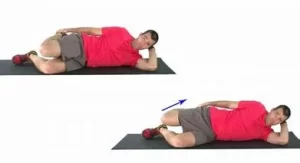
Which Precautions must be taken during exercising?
- When doing the exercise, keep your posture correct.
- To properly perform the exercise, extend, hold, and repeat.
- Stay away from uncomfortable workouts.
- If an unexpected pain arises, stop working out.
- Obtain the Correct Balance
- Between exercises, take a break.
- Make minimal bends and stretches.
- When working out, try not to make forceful knee movements.
- Wear loose clothing so that your body may move easily while working out.
- If the muscles feel stiff, stretch them; however, you should never feel sharp or severe pain.
When should you stop exercising?
- Intense burning in the muscles
- You’re experiencing illness.
- If you experience any numbness or pain.
- Heatstroke
- Exercise should be stopped if it hurts.
With pes anserine bursitis, what kind of activities should you avoid?
- Stay away from climbing stairs
- Avoid high-impact activities.
- Running
- Jumping
- Playing sport
- Steps from a long walk
Helpful recommendations:
- Think about including your workouts in your routine.
- Completing each exercise in a single session is not required.
- You don’t have to complete the exercise movement in its entirety the first time.
- If you have problems falling asleep, try using a cushion to support your knee.
- Proceed with your forward progress. You have to train your knee muscles for them to stay healthy.
Pes anserine bursitis: how common is it?
Athletes are most likely to get pes anserine bursitis. Adults with obesity and osteoarthritis are also at high risk for the illness. Anterior knee pain, or pain in front of the knee, is more common among obese women over 50, according to data.
Prevention:
A little prevention goes a long way. Maintaining proper muscle balance around the knee is important for possibly preventing pes anserine bursitis. Moreover, preparing before engaging in any physical activity is Stretching the muscles in the front, back, and inside the thigh and knee is advised. It’s important to gradually increase your level of exercise over time, especially after a period of relative inactivity or after surgery. By doing this, you can lower your risk of developing bursitis and other diseases that can arise from starting exercise again too soon. Keep in mind that in races, “the slow and steady wins the struggle.”
Summary:
Inflammation of a fluid-filled sac (bursa) on the inside of the knee is the result of pes anserine bursitis. It hurts when you bend your knee, climb and go downstairs, or get out of a chair. Damage, illness, or overuse are the causes of this issue. Those who engage in repetitive motions at work, elderly individuals, and athletes are particularly vulnerable to this issue. Women in their middle years who weigh more than is considered healthy also frequently experience it.
Most of the time, conservative measures like rest, ice, painkillers, and specific exercises are helpful. Never forget that you should always get medical advice before beginning a new fitness regimen, particularly if you have pes anserine bursitis. They can design an individual plan just for you.
FAQs
How can pes anserine be avoided?
In trying to avoid pesanserine bursitis, a daily exercise plan can help strengthen and stretch the muscles in the middle of your body, upper legs, and knees.
Which workouts are most effective for pes anserine?
exercises that will strengthen, stretch, and improve the flexibility of your joints.
Exercises like heel slides, hamstring curls, quadriceps, and calf stretches are some examples of these.
Which exercises worsen bursitis?
high-impact activities. Increase the force applied to the joints and muscles. The bursa may get irritated and more painful when walking far away.
Does pes anserine bursitis result from squats?
Going up and down stairs, getting in and out of a chair, and performing exercises like lunges or squats are common factors for the pain, which progressively gets worse. Running athletes who may have poor form are also subject to this syndrome. One may notice swelling and tenderness in the pes anserine area.
With pes anserine bursitis, is walking acceptable?
Rest, ice, and medications that are anti- and physical therapy exercises are effective treatments for pes bursitis because the condition is typically caused by inflammation. Stay away from strenuous activities and extended walks, particularly on uneven surfaces.
What is the duration of healing for pes anserine?
healing. In three to six weeks, you can usually resume your regular activities if pes anserine bursitis is diagnosed.
Which three muscles attach to the pes anserine?
The tendinous insertions of the sartorius, gracilis, and semitendinosus muscles combine to form the pes anserinus (PA).
I have pes anserine bursitis; can I still exercise?
It is important for athletes who have pes anserine bursitis to adjust how they train to prevent further inflammation. Additional therapies consist of: Relax. Until the bursitis goes away, stop doing the activity or switch to something else.
What is the overuse of pes anserine?
Pain in the inner part of the knee caused by overuse, direct trauma, or underlying diseases like osteoarthritis is a common symptom of pes anserine bursitis. The prognosis for pes anserine bursitis is generally good.
Does bursitis in pes anserine go away?
In most cases, pes anserine bursitis or tendinopathy does not resolve on its own if the underlying cause is left untreated and you keep up your routine of physical activity. You should speak with the closest sports medicine specialist if you believe you may have pes anserine tendinopathy. Meanwhile, you can start the first course of treatment.
For pes anserine bursitis, is heat beneficial?
As the pressure increases on top of your injury, you’ll experience even more pain. Inflammatory bursitis injuries, new injuries (within the first 24 to 72 hours), injuries immediately following surgery, and injuries following a relapse are not well treated with heat. Heat therapy should be given later in the healing cycle in these situations.
With pes anserine bursitis, how can one sleep?
The amount of pain varies according to how much of your knee is inflamed.It can be very sharp or very mild. Many who suffer from knee bursitis suggest placing a pillow between your thighs and knees at night to help with pain during the night.
Can a cold help with bursitis?
As soon as you feel pain in your muscles or around a joint, apply ice or cold packs. For three days (seventy-two hours), apply ice for ten to fifteen minutes at a time, up to twice an hour. After the first 72 hours, you can experiment with heat or alternating heat and ice. Apply painkillers.
Does rest help with bursitis?
Usually, bursitis can be treated with rest. Stay out of the postures or activities that aggravated your bursa. Your body will have more time to heal and recover if you take a break from activities that strain that area. Find out from your doctor how long you’ll need to take it easy and refrain from exercising.
Is bursitis long-term or short-term?
While crystalline joint disease, trauma, or infections are the usual causes of acute bursitis, inflammatory arthropathies and repetitive strain/overuse, or “micro traumas,” are more likely to cause chronic bursitis. Patients with acute bursitis usually have pain when the bursa is palpated.
Does the pain associated with pes anserine bursitis worsen at night?
Individuals experiencing knee bursitis may also have trouble sleeping. Merely bending your knee or turning over while you sleep can put pressure on the bursa that is inflamed, which will exacerbate your pain. Depending on how much inflammation there is in your knee, the pain can be anywhere from moderate to excruciating.
Who suffers from bursitis the most?
Often impacted are men in their middle years. That’s likely because their occupations are more frequently linked to an increased risk of bursitis. Within two to three weeks, the inflammation usually goes away if the area is rested.
Does bursitis in the pes anserine last forever?
The condition Pes anserine bursitis/tendinopathy has no long-term effects as long as it is correctly recognized and treated. If not, you could have to take an extended break from sports and other activities due to chronic pain in the region right below the inside of the knee.
For pes anserine bursitis, is cycling beneficial?
An overuse injury called pes anserine bursitis is frequently made worse by exercises like squatting, cycling, and jogging. If both the tendon and the pes anserine bursa are affected, the pain may be extremely intense. Often, the pain gets worse after activity and gets better afterward.
How is pes anserine bursitis tested for?
Your doctor will examine your knee and talk to you about your problems. The symptoms of pesanserine bursitis might be mistaken for those of a stress fracture, so an X-ray is usually required for the diagnosis.
References:
- Knee Tendon Bursitis Caused by Pes Anserine – OrthoInfo – AAOS. (n.d.). https://orthoinfo.aaos.org/en/diseases–conditions/pes-anserine-knee-tendon-bursitis/
- A. Patil (2021). The exercises for biomechanical correction in PES anserine bursitis. 10(3), 2337–2339, Journal of Medical Pharmaceutical and Allied Sciences. The URL is 10.22270/jmpas.v10i3.1079.
- Exercises for Knee (Pes Anserine) Bursitis | Kaiser Permanente, n.d. The Kaiser Permanente. The article “He.Knee-Pes-Anerine-Bursitis-Exercises.bo1586” can be found at https://healthy.kaiserpermanente.org/health-wellness/health-encyclopedia.
- Bursitis Pes Anserine (2008). Orthopedics, 31(4). 10.3928/01477447-20080401-30 is the doi link.
- 2022, December 21; Giorgi, A. Escherichia bursitis: What Is It? Verywell Medical Center. PES Anserine Bursitis 6890790 https://www.verywellhealth.com
- С. (2020). Vestnik.uriu.ranepa.ru/wp-content/uploads/2020/10/48-53-1.pdf is the URL for this file. NORTH CAUCASUS LEGAL VESTNIK, 1(3), 54–58. https://doi.org/10.22394/2074-7306-2020-1-3-54-58
- Image 2, K. P. explained (2020, March 17). Knee Pain Explained: Enhance Your Flexibility with Calf Stretches. Pinterest. PIN: 249105423127107410 from Pinterest
- Image 14, Online store 51898664. (n.d.). The product details for 51898664.html can be found here.

